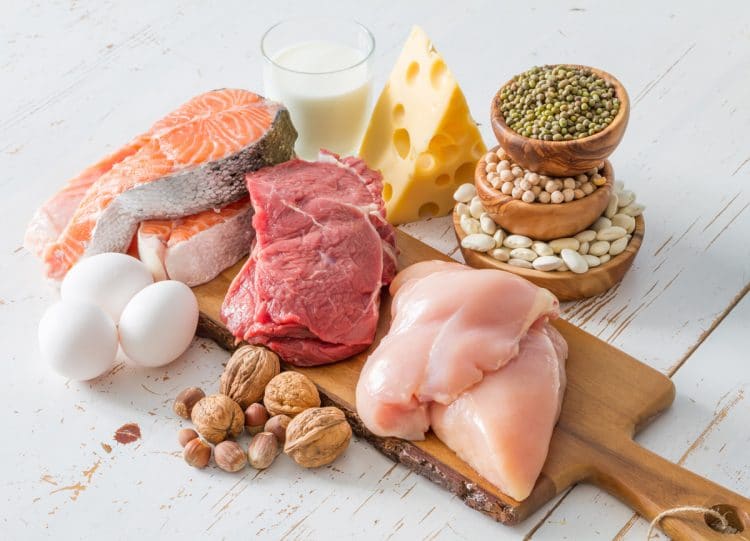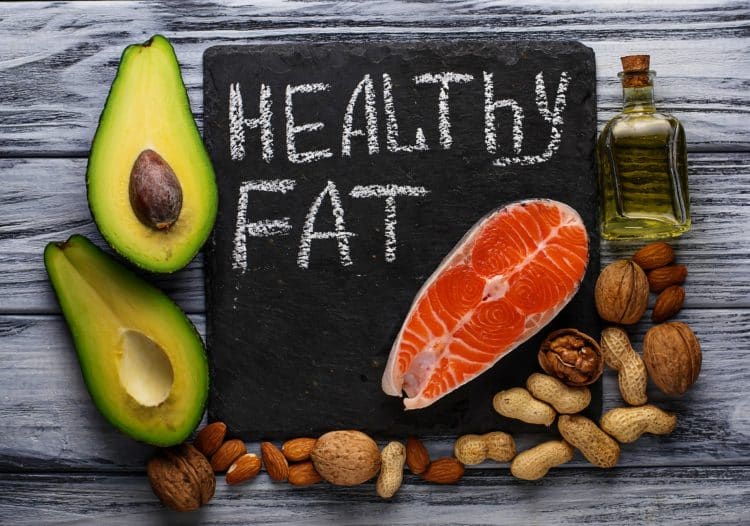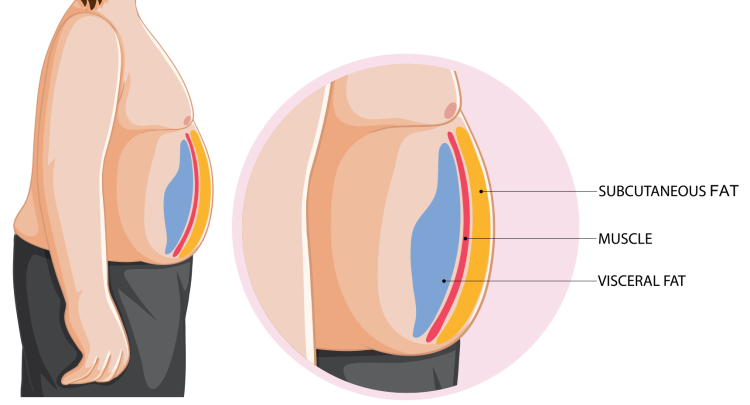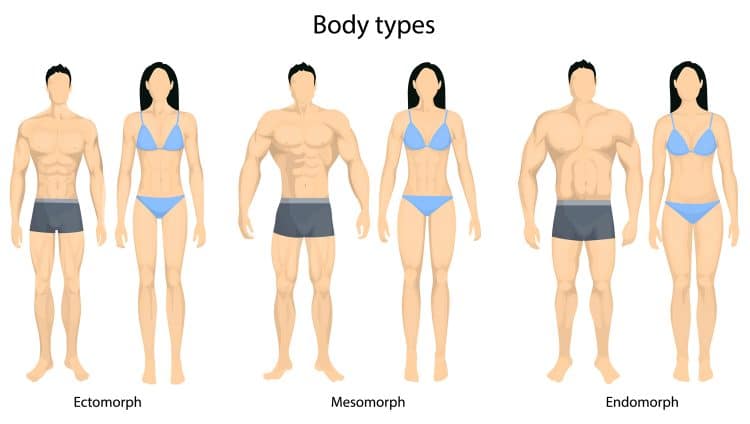Are you underweight? Do you want to gain weight without getting fat? We hear you, and we’re here to help!
According to recent World Health Organization (WHO) statistics, 42.4% of adults in the United States are overweight or obese (1). The WHO also reports that the number of obese adults in the US has increased steadily over the past few decades. In 1999–2000, 30.5% of adults in the United States were obese, but by 2017–2020, this number had increased to 42.4%. Obesity levels are soon expected to hit 50%.
Needless to say, this means a large number of adults are a) worried about their weight and b) desperate to shed the excess pounds that are literally dragging them toward an early grave.
While this might sound dramatic, it’s estimated that overweight people have a 53% increase in mortality (premature death) risk than people who are a healthy weight. High levels of body fat increase your chances of dying from:
- Heart disease
- Hypertension
- Stroke
- Type 2 diabetes
- Chronic kidney disease
- Fatty liver disease
- Alzheimer’s and other forms of dementia
- Some types of cancer, including breast cancer, colon cancer, pancreatic, and endometrial cancer
On the flip side, as sobering as those statistics are, a small percentage of the population is actually underweight. While being slender is rarely a significant health risk, there are several reasons to want to gain weight, including improved aesthetics, better self-image, or a job requirement, e.g., firefighter, police officer, or soldier.
Unfortunately, gaining weight is not always easy, especially if you want to avoid the trap of gaining belly fat. Belly fat is one of the reasons that being overweight is so unhealthy.
In this article, we reveal the strategies you can use to gain weight without gaining belly fat.
What Is Belly Fat, And Why Is It Dangerous?
Body fat is stored energy, and we all have it. It’s generally accepted that one pound contains roughly 3,500 calories. Even a lean 170-pound person with ten percent body fat has approximately 17 pounds of body fat, which equals about 59,500 calories, or enough energy to run around 23 marathons! Needless to say, if you are 25, 50, or 100 pounds overweight, your energy reserves are much larger.
However, it’s not just the amount of fat you have on your body that matters, but where that fat is stored.
Firstly, there is subcutaneous fat, which is fat stored between your skin and muscles. While subcutaneous fat can be unsightly and will affect your definition, it doesn’t present a significant health risk. If you have fat around your arms, legs, or butt, that’s subcutaneous fat.
In contrast, fat around your midsection is commonly known as visceral or belly fat. This type of fat is stored in the abdominal cavity and surrounds vital organs like the liver, pancreas, and intestines, and is much more dangerous to your health.
Doctors often call fat stored around the abdomen “heart attack fat,” as the more fat you have in this area, the more likely you are to suffer from cardiac health issues and other life-shortening diseases (2, 3, 4).
That’s because visceral fat has a direct, negative effect on the organs it surrounds. These effects include:
- Increased Inflammation: Visceral fat releases chemicals that induce inflammation, a foundational issue in many chronic diseases, including cardiovascular conditions. Inflammation is literally the reddening and swelling of cells and tissues. That’s bad news on the outside of your body, let alone the inside.
- Insulin Resistance: Belly fat hampers your body’s ability to use insulin, increasing the risk of Type 2 diabetes and metabolic issues. Chronically elevated blood glucose and the accompanying increase in insulin production increase your risk of heart disease, some cancers, and premature aging.
- Elevated Stress Hormones: Visceral fat affects hormones like cortisol that regulate stress, potentially leading to heightened anxiety and stress-related eating. Chronically elevated cortisol levels can have a significant impact on long-term health.
- Liver Strain: Being close to the liver, visceral fat releases fatty acids that can lead to liver disease and metabolic dysfunction. Fatty liver disease, where fat is stored within the liver, is a serious health risk.
- Increased Blood Pressure: Chemicals from visceral fat can constrict blood vessels, contributing to high blood pressure. High blood pressure affects the health of many organs, including the heart and kidneys.
- Impaired Immunity: Visceral fat weakens your immune defenses, making you more prone to infections and other illnesses.
By directly affecting these vital functions and organs, visceral fat earns its reputation as “heart attack fat” and poses a serious risk to overall health.
So, why are we telling you all this? Because gaining weight, especially if you do it the wrong way, could lead to an increase in belly fat. So, while it might help you reach your target weight, belly fat is anything but healthy.
As such, any weight gain protocol should help you gain weight without increasing belly fat stores. This is critical for your health and longevity.
So, now you know what belly fat is and why you want to avoid accumulating it, let’s look at how you can gain weight without increasing your waist measurement.
How to Gain Weight Without Gaining Belly Fat: The Ultimate Guide
Firstly, it’s essential to recognize that everyone has some visceral fat. It typically makes up around 10% of the total body fat percentage in healthy individuals. However, because of diet, exercise, and lifestyle choices, not to mention genetics, some people are more prone to belly fat than others.
Given the widely known dangers of belly fat, it makes sense to try and minimize belly fat and avoid gaining more than is strictly necessary.
Here are some proven strategies for gaining weight without belly fat.
1. Gain Muscle, Not Fat
Your body weight is the sum total of several types of tissue, often called components. These components include:
- Fat
- Muscle
- Bone
- Internal organs
- Skin
- Fluids (water, blood, etc.)
Theoretically, you can gain (or lose) weight by manipulating any of these components. However, it’s usually best to try and gain muscle weight as doing so is the healthiest. Gaining muscle will improve how you look, feel, and perform. In contrast, gaining fat is usually not recommended for all the reasons discussed elsewhere in this article.
Muscle is very dense, and a cubic inch of muscle weighs 0.976 oz compared to the same amount of fat, which weighs 0.832 oz.
Building muscle, a process called hypertrophy, involves a combination of strength training and nutrition. In other words, you’ll need to start thinking and acting like a bodybuilder.
Please check out this article for more information on eating and exercising for muscle gain.
2. Create A Small Calorie Surplus
When it comes to gaining weight, many people make the mistake of eating far more than they need. While this will result in weight gain, a large percentage of this weight will be fat. It’s generally best to gain weight slowly to avoid accumulating too much fat.
Consequently, you should aim to consume about 250-300 calories more than you need to maintain your weight. These extra calories are often referred to as a surplus. This modest surplus should be enough to fuel muscle growth without resulting in excessive fat accumulation.
You can determine your ideal caloric intake using this calculator. Not gaining weight? Just dial up your calorie intake by an additional 100-200 calories until the needle on the scale starts to move.
3. Gain Weight Slowly
While most people want to gain weight quickly, this is a common cause of belly fat. Faced with a hefty calorie excess, your body has no choice but to shunt those unwanted calories into your fat cells, including those around your midsection. This is a bit like trying to fill a cup from a fast-running faucet – you’re bound to overfill it and spill water everywhere.
However, if you gain weight slowly, you can control fat gain and are less likely to gain belly fat. You can fine-tune the flow of calories so that you don’t overfill your cup.
So, aim to gain 0.5 to 1.0 pounds per week and no more. Slower weight gain is always better than gaining weight quickly, especially for avoiding visceral fat.
4. Prioritize Protein

Protein is critical for gaining muscle while minimizing fat gain. Where dietary carbs are readily converted into glucose and stored as fat, protein is not. However, your body needs an abundance of protein to fuel muscle growth.
Precisely how much protein you need to build muscle is up for debate. Still, it’s generally accepted that most people need 0.7 to 1.0 grams per pound of body weight. Alternatively, you can get a more accurate protein prescription by using this calculator.
Good sources of protein for building muscle include:
- Almonds
- Black beans
- Chicken breast
- Cottage cheese
- Eggs
- Greek yogurt
- Lentils
- Quinoa
- Salmon
- Seitan
- Shrimp
- Tempeh
- Tofu
- Turkey breast
- Whey protein
Related: List of 40 Protein-Packed Foods
5. Incorporate Healthy Fats

Of the three food groups, protein and fat contain four calories per gram, while fat contains nine. As such, fat can help fuel weight gain. However, where some fats are quite unhealthy, others are the opposite and will do you nothing but good. Needless to say, it’s these healthy fats you need to consume more of.
That’s because, as well as being a valuable source of calories, healthy fats can help reduce inflammation, are good for your heart, offer benefits for your brain, and regulate hormone levels.
Examples of healthy fats include:
- Avocado
- Chia Seeds
- Coconut Oil
- Dark Chocolate
- Extra Virgin Olive Oil
- Flaxseeds
- Ghee
- Hemp Seeds
- Nuts and Nut Butters
- Oily Fish (Mackerel, Sardines, Trout, Wild Salmon)
- Pumpkin Seeds
- Sunflower Seeds
Related: Fat Intake Calculator
6. Choose the Right Carbs

Low-carb diets can be effective in helping people lose weight. Reducing or eliminating carbs from your diet automatically lowers your calorie intake and also helps reduce blood glucose and insulin production, which may enhance fat burning. As such, low-carb diets are very popular.
However, carbs are your friend if you want to gain weight, but you must choose the right sources. By this, we mean your sources of carbohydrates should be relatively unprocessed, low in sugar, high in fiber, and contain lots of vitamins and minerals.
These “good” carbs are an excellent source of slow-releasing energy and offer myriad health benefits. They’re also cheap, satisfying to eat, and readily available. So, when trying to gain weight without belly fat, healthy carbs, like those listed below, should be a cornerstone of most meals.
Good carb sources for healthy weight gain include:
- Apples
- Bananas
- Barley
- Berries (strawberries, blueberries, raspberries)
- Brown rice
- Buckwheat
- Cherries
- Dates
- Grapes
- Lentils
- Mangoes
- Oats
- Oranges
- Peaches
- Pineapple
- Quinoa
- Sweet potatoes
- Whole grain bread
- Whole grain pasta
- Wild rice
Related: Carbohydrate Calculator
7. Limit Sugar and Processed Foods
Gaining weight is not an excuse to binge on junk food. While sugary snacks and processed meals contain a lot of calories, they won’t provide any of the nutrients and fiber your body needs to function correctly.
The sugar they contain causes a rapid rise in blood glucose, triggering the release of insulin. High insulin levels promote visceral fat storage, and as sugar is also inflammatory, it’s terrible for your health.
A diet that’s high in sugar also sets you up for a rollercoaster of energy highs and lows, not to mention long-term health issues like Type 2 diabetes and numerous cancers. Fat is often labeled as the nutritional bad guy, but, in reality, it’s sugar that’s the most harmful nutrient.
In addition, the high salt content in processed foods can wreak havoc on your blood pressure by causing water retention, putting strain on your kidneys.
So, just because you want to gain weight doesn’t give you a free license to fill up on junk food. Instead, build your diet around calorie-dense yet natural foods, including those all-important healthy fats and good carbs.
8. Eat Frequently
Many naturally slender people have small appetites, and the advice to “eat more” is not always helpful. After all, if you feel full after a small meal, eating more is impractical and unappealing.
One way around this is to eat more frequently. So, instead of the traditional “three square meals” per day, up your meals to five or even six. These meals don’t have to be big; you’ll get your extra calories simply because you eat more often.
So, start your day with breakfast, and then have a second breakfast a few hours later. Apply this same methodology to all your meals, and you’ll have no problem consuming enough calories to gain weight.
If the idea of eating so many meals is daunting, consider having some of them in liquid form, e.g., milkshakes and smoothies. You can make these yourself out of healthy ingredients and consume them on the go. And, as an added advantage, they’re not as filling as solids. Here’s an example meal in a glass smoothie:
- 1 cup plain Greek yogurt
- 1 cup water
- 1 scoop whey protein powder (vanilla/chocolate)
- 1 ripe banana
- 1 tablespoon peanut butter powder
- 1 tablespoon raw honey
Put all the ingredients into a blender with a few ice cubes and blitz for 30-60 seconds. Consume immediately or put it in a thermos for later. Simple and delicious!
Nutritional Breakdown:
- Protein: 45.3g
- Carbs: 59g
- Fat: 19.3g
- Calories: 560
Related: How to Calculate Macros for Weight Management
9. Manage Stress Levels
Stress is an inescapable part of life. Work, finances, and relationships can all be sources of stress.
In the distant past, stress was critical for keeping you alive in dangerous situations. When faced with a hazard, your body triggered the stress “fight or flight” response so you could battle or run to safety. Then, once you were clear and safe, your body would power down, and stress levels would dissipate.
However, modern life can be chronically stressful, leaving you in that fight-or-flight state for days or weeks at a time. This is very unhealthy and can cause fat to accumulate around your abdomen (6). This effect is essentially the fault of cortisol and insulin.
While it’s impossible to avoid stress entirely, you can take steps to reduce it and cope with it better. Stress-beating strategies include:
- Regular exercise
- Breathing exercises
- Seeking support
- Mindfulness meditation
- Progressive muscle relaxation
- Positive visualization
- Journaling
- Getting enough sleep
- Avoiding triggers
- Time management
- Setting realistic goals
- Avoiding perfectionism
- Prioritizing tasks
- Limiting caffeine and alcohol
10. Get Quality Sleep
Sleep may seem unconnected to your ability to gain weight without belly fat. Still, it’s actually a critical part of the process. Firstly, sleep is when your body does most of its muscle repair and growth, and too little sleep will undermine your workout results.
Secondly, not getting enough sleep can increase insulin resistance. When this happens, your body is more likely to convert unused calories into visceral fat (5).
Finally, sleep deprivation makes it harder to eat healthy and exercise. Being tired severely undermines your energy and motivation. In short, too little sleep can give you a severe case of the I-can’t-be-bothereds!
Most adults need 7-9 hours of sleep per night, but getting enough rest is not always easy. For most, it means going to bed earlier, as you probably won’t be able to delay getting up because of work and familial commitments.
So, be prepared to turn off your TV, put down your phone or tablet, and head to bed an hour or so earlier than usual. While this habit may take a while to develop, gradually, you’ll get used to your earlier bedtime and will probably wonder why you ever tried to get by on less sleep. Getting enough sleep is one of the best things you can do for your health, and it requires very little effort.
You can read more about the importance of sleep here.
11. Monitor Progress Regularly
While your scales will tell you if you are gaining weight, they won’t tell you if you are also gaining belly fat. Doctors use CT, DEXA, ultrasound, and MRI scans to measure belly fat. Still, those tools are probably impractical and inaccessible for most – at least for regular use.
The good news is that you can (and should) monitor levels of belly fat using a simple tape measure. If you notice your waist is expanding, it’s safe to say you are gaining belly fat, and you need to dial back your weight gain efforts. Track your waist measurement monthly to determine if the weight you are gaining is muscle or visceral fat.
Speaking of waist measurements, there are accepted norms that, when exceeded, suggest your belly fat levels are high enough that they may harm your health.
For Men:
- High Risk: Waist circumference greater than 40 inches (102 cm)
- Moderate Risk: Waist circumference between 37 and 40 inches (94-102 cm)
For Women:
- High Risk: Waist circumference greater than 35 inches (88 cm)
- Moderate Risk: Waist circumference between 31.5 and 35 inches (80-88 cm)
However, your waist measurement relative to your height is arguably more important. After all, taller people often have larger waists, even when levels of belly fat are low. Using the waist-to-height ratio, you can determine your health risks regarding your waist size.
The ideal waist-to-height ratio is generally considered to be 0.5 or less (7). To calculate this, divide your waist circumference by your height. Both should be in the same unit (inches or cm).
So, for example, if your waist is 32 inches and your height is 64 inches, then your waist-to-height ratio would be 0.5.
Baffled by all this math? We hear you! Discover your waist-to-hip ratio with our handy online calculator.
12. Be Patient
Trying to gain weight too quickly increases your risk of developing belly fat. So, rather than trying to gain as much weight in as short a time as possible, pump the brakes and make a long-term plan where you aim to gain about 0.5 to 1.0 pounds per week. This slow but steady approach should lead to more muscle than fat gain, although some extra body fat is all but unavoidable. Slow and steady is the way to win the healthy weight gain race!
Related: How Much Muscle Can You Gain in a Month?
You now have all the information you need to gain weight without belly fat. Still want more? Then check out the frequently asked questions (FAQs) below!
FAQ’s
Are you still hungry for knowledge about gaining weight without belly fat? Check out this FAQ to learn even more about this topic.
1. What is the difference between subcutaneous and visceral fat?
Subcutaneous fat is stored between your muscles and skin. It’s the fat you can pinch between your fingers and thumb on your waist, legs, or arms. It has a relatively low impact on your health, although too much is never a good thing.
In contrast, visceral fat is stored around your internal organs within the abdominal cavity. Visceral fat is considered very harmful to your health, and it’s best to avoid accumulating too much. The dangers of excess visceral fat include:
- Alzheimer’s disease
- Asthma
- Breast cancer
- Cardiovascular disease
- Colorectal cancer
- Diabetes (type 2)
- Fatty liver disease
- Gallbladder issues
- High blood pressure
- Insulin resistance
- Metabolic syndrome
- Sleep apnea
2. How can I measure my waist-to-height ratio at home?
Measuring your waist-to-height ratio is a simple task for which you’ll need a tape measure, pen, paper, and a calculator. Follow these steps to determine your waist-to-height ratio.
- Locate Your Waist: Your natural waist is the narrowest part of your torso, usually just above your belly button. Place your hands on your sides and bend to one side; where you crease is your natural waist.
- Measure Your Waist: Wrap the tape measure around your waist, making sure it’s level all the way around. Don’t pull too tight; the tape should be snug but not digging into your skin.
- Record the Measurement: Take note of the measurement in inches or centimeters.
- Measure Your Height: Stand against a wall and mark the top of your head. Measure from the floor to the mark. Record this measurement, ensuring it’s in the same unit as your waist measurement (inches or centimeters).
- Calculate the Ratio: Use a calculator to divide your waist measurement by your height measurement.
- Interpret the Result: A waist-to-height ratio of 0.5 or less is generally considered healthy. Ratios above this may indicate a higher risk of health issues related to visceral fat.
3. Is it possible to gain muscle mass without gaining any fat?
Gaining muscle mass without gaining at least a little fat is probably impossible. Building muscle requires extra energy, often called a calorie surplus. It’s not possible to say exactly how many extra calories you need, so it’s always better to overestimate than underestimate. Too few calories will undermine your progress.
As such, there will always be a few too many calories in your energy surplus, and they’ll be converted to and stored as fat.
However, you can minimize fat gain by keeping your surplus small, e.g., 200-300 calories per day, and following the other tips in this guide.
4. What are some common mistakes people make when trying to gain weight?
Given how many people are currently overweight, you’d think that gaining weight would be easy. However, there are several mistakes you can make that lead to gaining belly fat. Common missteps that people make when trying to gain weight without belly fat include:
- Choosing the wrong carbs
- Ignoring healthy fats
- Ignoring stress management
- Inconsistent eating schedule
- Lack of sleep
- Neglecting protein
- Not tracking progress
- Overeating calories
- Overeating sugar and processed foods
- Skipping strength training
- Trying to gain weight too fast
- Undereating
Avoid these pitfalls, and you should be well on your way to gaining weight without belly fat.
5. How do hormones like cortisol and insulin affect weight gain and fat distribution?
Hormones like cortisol and insulin are pivotal in weight gain and fat distribution. Controlling these hormones can help make your weight gain journey easier and healthier.
Elevated cortisol levels, often caused by chronic stress, can lead to fat accumulation around your midsection.
In contrast, insulin is a double-edged sword. While it’s essential for driving nutrients into your cells, high levels can promote abdominal fat storage, especially when your diet is high in processed carbs and sugars.
So, if you want to gain weight without belly fat, you must keep these hormones in check.
6. Can I still enjoy some junk food while trying to gain weight healthily?
While junk food is high in calories and can help you gain weight, it should not be a cornerstone of your diet. That’s because it’s typically high in sugar and low in fiber, which can contribute to visceral fat gain.
So, by all means, enjoy the occasional unhealthy snack or meal, but make sure the majority of your calories come from nutrient-dense foods, such as whole grains, lean proteins, fruits, vegetables, and healthy fats.
7. What role do genetics and gender play in weight gain and fat distribution?
Women tend to gain fat more easily than men and store that fat on their hips and thighs. Men, in contrast, are typically leaner but store their fat around their abdomens. These gender fat deposition sites are often called gynoid and android or apple and pear-shapes.
However, genetics can also play a part, as your genes determine your hormone levels and propensity for body fat storage. For example, some people are naturally slimmer than others or store fat in areas less common for their gender.
With all that said, it’s important to note that your genetics, while unmodifiable, are not insurmountable, and you can always make lifestyle, diet, and nutritional changes to affect fat storage and burning. But, your genes may determine your overall rate of progress and success. For example, not everyone can get a six-pack.
8. How can I adjust my diet if I’m not seeing the weight gain results I want?
If you are eating well and training hard but still not gaining weight, you may need to dial up your caloric intake. Not eating enough is the most common cause of non-weight gain. Try adding a few high-calorie snacks to your daily food intake or increasing the size of some of your meals.
In addition, you could also look for ways to reduce your daily energy expenditure, which may be detracting from your calorie surplus.
Get the balance right between calorie intake and calorie burning, and you should gain weight. If you still cannot gain weight, you should consult your doctor as it may be a sign of a metabolic disorder.
9. Are there any supplements that can help me gain weight without adding belly fat?
Your diet and exercise program are the cornerstones of gaining weight without belly fat. You also need to consider sleep, stress, and your general lifestyle. However, there are a few supplements that might enhance your results. That said, none of them will undo the damage of a poor diet, too little sleep, or inadequate workout routine. These include:
- Whey/casein protein
- Creatine
- Branched-Chain Amino Acids (BCAAS)
- Omega-3 fatty acids
- L-glutamine
- Vitamin D
- Zinc
- Magnesium
- Cinnamon
- Turmeric
- Fenugreek
- Ginger
10. How often should I adjust my workout routine for optimal muscle gain?
Even the best workout will lose some of its potency if you do it for too long. It’s like your body gets bored of doing it and rebels by creating a progress plateau. As such, it’ll be necessary to change your program from time to time to continue gaining muscle.
However, how often you need to change your program depends on you. Some people may need to change their workout every 4-6 weeks, while others will continue to make progress for 2-3 months before they need a change.
With that in mind, you should monitor your progress and change workouts when you no longer see noticeable changes in muscle mass and body weight. Do not stick with a program that no longer works, as doing so is a waste of your time and energy.
Closing Thoughts
Despite obesity being so prevalent, there are still people who consider themselves underweight. This may be because they feel skinny or need to be a certain weight for their career, e.g., firefighting or the military.
The good news is that gaining weight is a relatively straightforward process, as the large and ever-growing percentage of the population clearly demonstrates.
However, the last thing you should accumulate is visceral or belly fat. This type of fat is inextricably linked to poor health and a shorter life span. As such, it’s probably best to stay skinny than develop a fat waist.
That said, building muscle is a healthy way to increase your body weight. Building muscle takes time, effort, and energy, but the results will improve your aesthetics, health, and physical performance. Your investment will pay off!
So, use the information in this comprehensive guide to gain weight without belly fat. Create and execute your diet and exercise plan, monitor your progress, and you’ll soon be on your way to a heavier you – heavier, but without excess belly fat!
References:
- Centers for Disease Control and Prevention: Adult Obesity Facts
- Bawadi H, Katkhouda R, Tayyem R, Kerkadi A, Bou Raad S, Subih H. Abdominal Fat Is Directly Associated With Inflammation In Persons With Type-2 Diabetes Regardless Of Glycemic Control – A Jordanian Study. Diabetes Metab Syndr Obes. 2019 Nov 22;12:2411-2417. doi: 10.2147/DMSO.S214426. PMID: 31819567; PMCID: PMC6878926.
- Bergman RN, Kim SP, Catalano KJ, Hsu IR, Chiu JD, Kabir M, Hucking K, Ader M. Why visceral fat is bad: mechanisms of the metabolic syndrome. Obesity (Silver Spring). 2006 Feb;14 Suppl 1:16S-19S. doi: 10.1038/oby.2006.277. PMID: 16642958.
- Lee YH, Park J, Min S, Kang O, Kwon H, Oh SW. Impact of Visceral Obesity on the Risk of Incident Metabolic Syndrome in Metabolically Healthy Normal Weight and Overweight Groups: A Longitudinal Cohort Study in Korea. Korean J Fam Med. 2020 Jul;41(4):229-236. doi: 10.4082/kjfm.18.0122. Epub 2020 Apr 29. PMID: 32344994; PMCID: PMC7385301.
- Reutrakul S, Van Cauter E. Sleep influences on obesity, insulin resistance, and risk of type 2 diabetes. Metabolism. 2018 Jul;84:56-66. doi: 10.1016/j.metabol.2018.02.010. Epub 2018 Mar 3. PMID: 29510179.
- Epel EE, Moyer AE, Martin CD, Macary S, Cummings N, Rodin J, Rebuffe-Scrive M. Stress-induced cortisol, mood, and fat distribution in men. Obes Res. 1999 Jan;7(1):9-15. doi: 10.1002/j.1550-8528.1999.tb00385.x. PMID: 10023725.
- Browning LM, Hsieh SD, Ashwell M. A systematic review of waist-to-height ratio as a screening tool for the prediction of cardiovascular disease and diabetes: 0·5 could be a suitable global boundary value. Nutr Res Rev. 2010 Dec;23(2):247-69. doi: 10.1017/S0954422410000144. Epub 2010 Sep 7. PMID: 20819243.
منبع: https://fitnessvolt.com/gain-weight-without-belly-fat/





